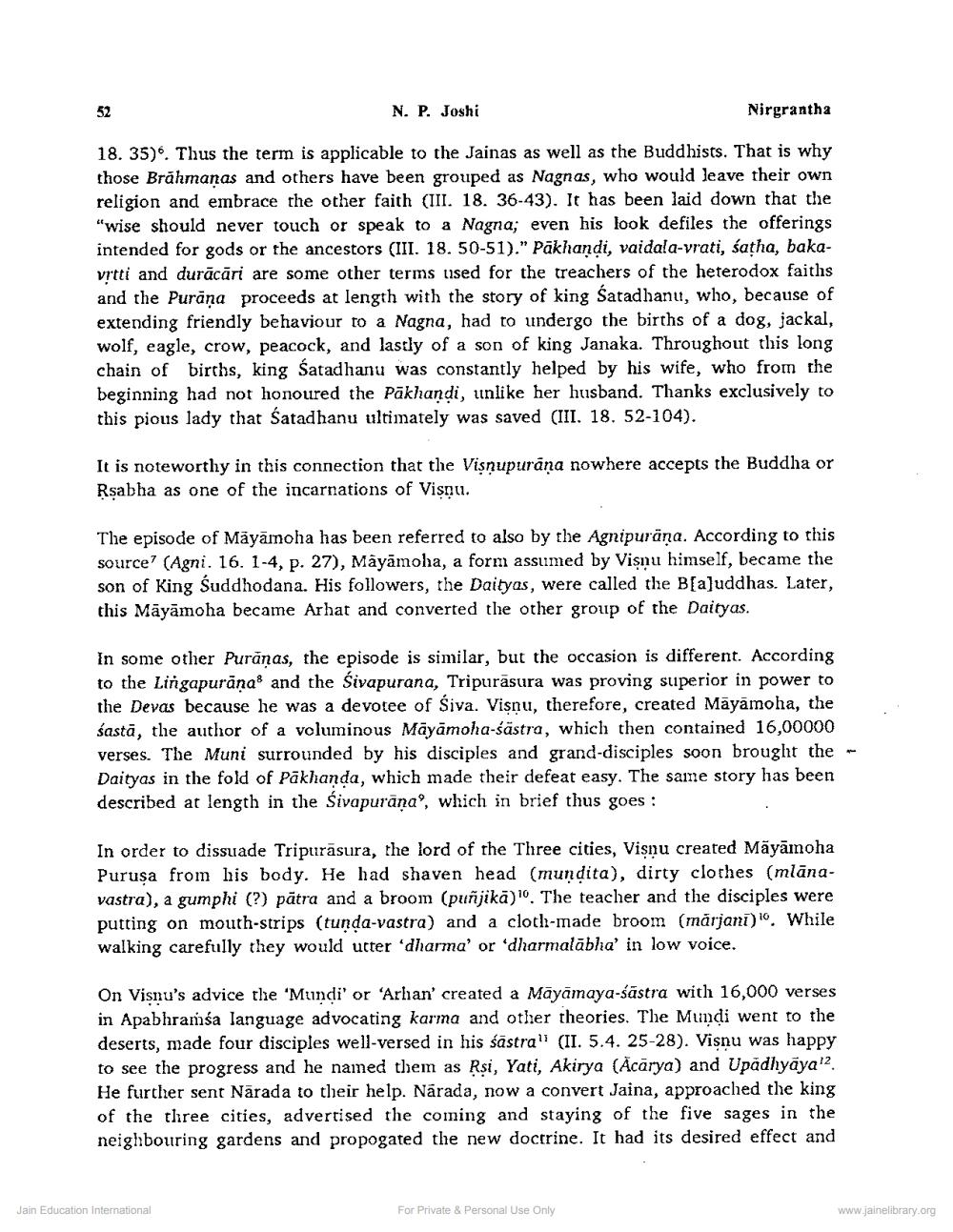Book Title: Teachers of Heterodox Sects Buddhism and Jainism in eyes of Puranas Author(s): N P Joshi Publisher: Z_Nirgrantha_1_022701.pdf and Nirgrantha_2_022702.pdf and Nirgrantha_3_022703.pdf View full book textPage 3
________________ N. P. Joshi Nirgrantha 18. 35). Thus the term is applicable to the Jainas as well as the Buddhists. That is why those Brāhmanas and others have been grouped as Nagnas, who would leave their own religion and embrace the other faith (III. 18. 36-43). It has been laid down that the "wise should never touch or speak to a Nagna; even his look defiles the offerings intended for gods or the ancestors (III. 18. 50-51)." Pakhandi, vaidala-vrati, satha, bakavịtti and durācāri are some other terms lised for the treachers of the heterodox faiths and the Purāņa proceeds at length with the story of king Satadhanu, who, because of extending friendly behaviour to a Nagna, had to undergo the births of a dog, jackal, wolf, eagle, crow, peacock, and lastly of a son of king Janaka. Throughout this long chain of births, king Satadhanu was constantly helped by his wife, who from the beginning had not honoured the Pākhandi, unlike her husband. Thanks exclusively to this pious lady that Satadhanu ultimately was saved (III. 18. 52-104). It is noteworthy in this connection that the Visnupurāņa nowhere accepts the Buddha or Rsabha as one of the incarnations of Visnu. The episode of Māyāmoha has been referred to also by the Agnipurāņa. According to this source? (Agni. 16. 1-4, p. 27), Māyāmoha, a form assumed by Vişnu himself, became the son of King Suddhodana. His followers, the Daityas, were called the B[a]uddhas. Later, this Māyāmoha became Arhat and converted the other group of the Daityas. In some other Puranas, the episode is similar, but the occasion is different. According to the Lingapurāna and the sivapurana, Tripurasura was proving superior in power to the Devas because he was a devotee of Siva. Visnu, therefore, created Māyāmoha, the sastā, the author of a voluminous Māyāmoha-śästra, which then contained 16,00000 verses. The Muni surrounded by his disciples and grand-disciples soon brought the - Daityas in the fold of Pakhanda, which made their defeat easy. The same story has been described at length in the sivapurana', which in brief thus goes : In order to dissuade Tripurasura, the lord of the Three cities, Vişnu created Māyāmoha Purusa from his body. He had shaven head (mundita), dirty clothes (mlānavastra), a gumphi (?) pātra and a broom (puñjikā). The teacher and the disciples were putting on mouth-strips (tunda-vastra) and a cloth-made broom (márjani)". While walking carefully they would utter dharma' or 'dharmalābha' in low voice. On Visnu's advice the 'Mundi' or 'Arhan' created a Māyāmaya-śāstra with 16,000 verses in Apabhramśa language advocating karma and other theories. The Mundi went to the deserts, made four disciples well-versed in his śāstra" (II. 5.4. 25-28). Visnu was happy to see the progress and he named them as Rsi, Yati, Akirya (Acārya) and Upadhyāya!2. He further sent Närada to their help. Narada, now a convert Jaina, approached the king of the three cities, advertised the coming and staying of the five sages in the neighbouring gardens and propogated the new doctrine. It had its desired effect and Jain Education International For Private & Personal Use Only www.jainelibrary.orgPage Navigation
1 2 3 4 5 6 7 8 9 10 11 12 13 14 15 16 17 18 19
